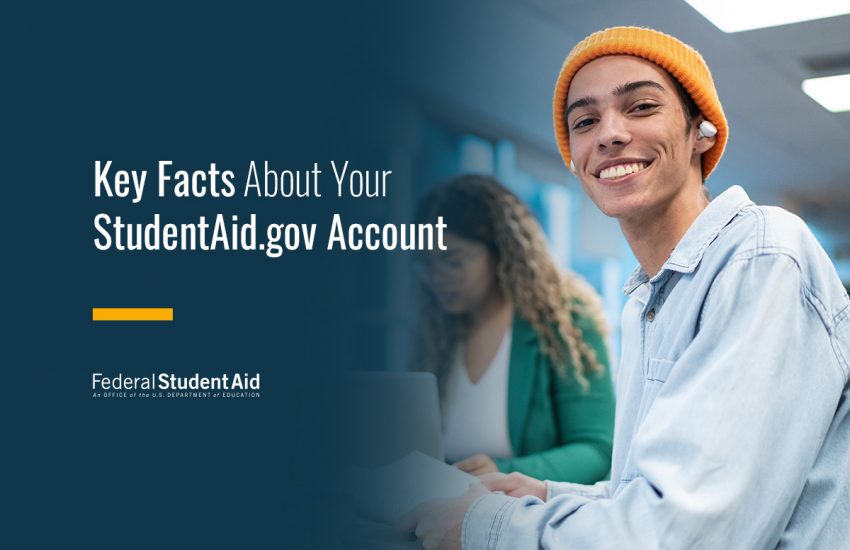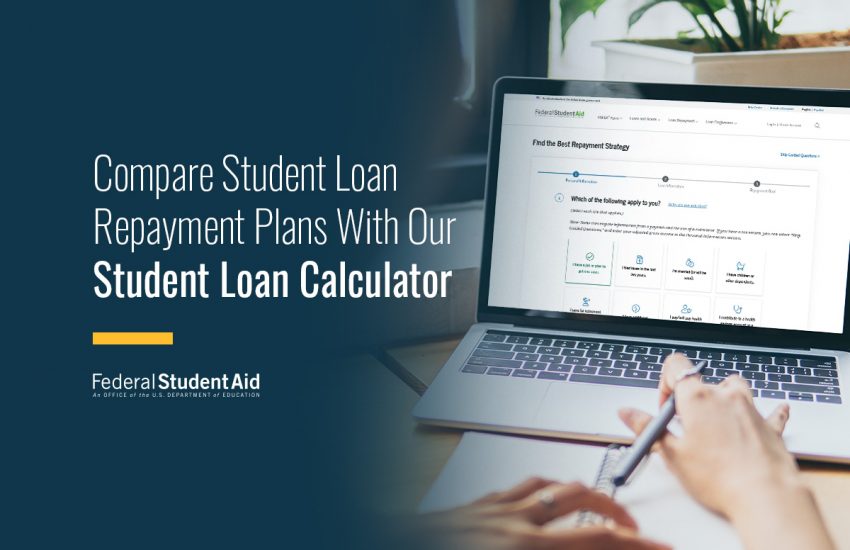7 Things To Do After Submitting Your FAFSA® Form
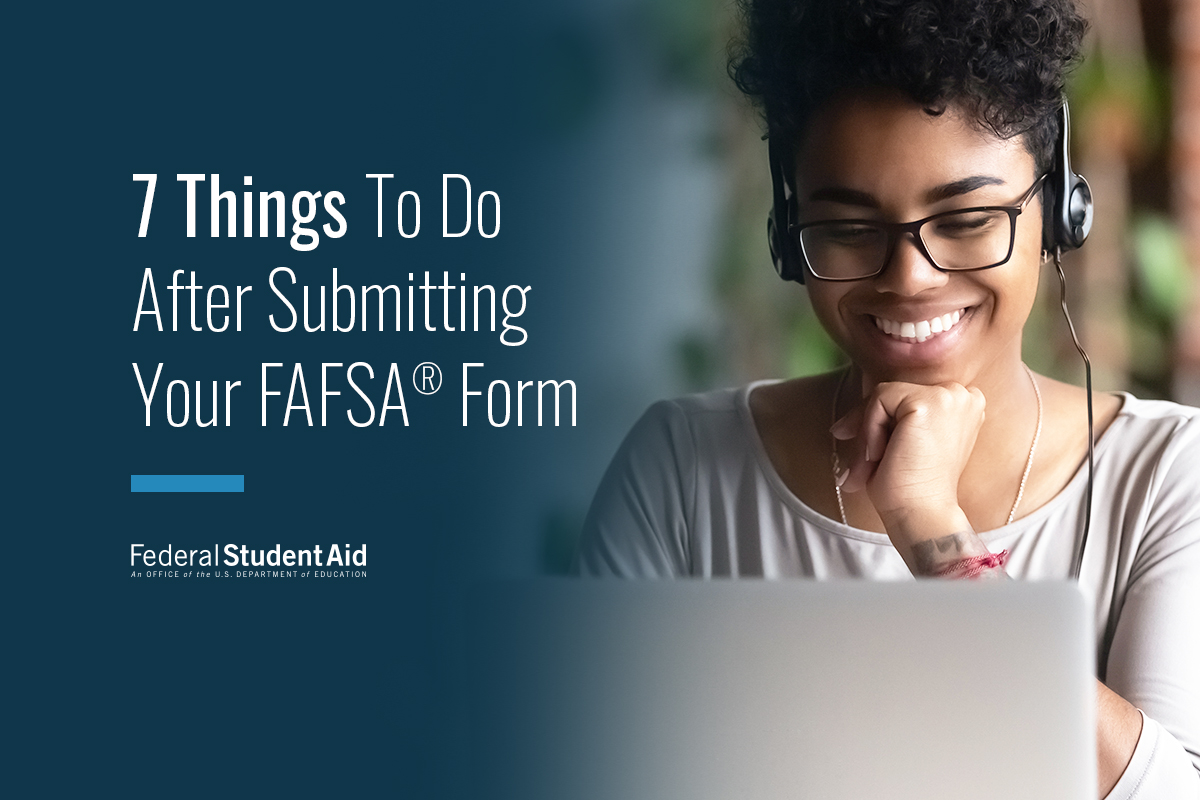
The financial aid process doesn’t end once you submit your Free Application for Federal Student Aid (FAFSA®) form. There are still seven things you should do after you complete your form:
- Check your FAFSA confirmation page.
- Review your FAFSA Submission Summary.
- Make corrections, if needed.
- Complete your state’s aid application.
- Compare schools and out-of-pocket costs.
- Apply for scholarships.
- Evaluate your aid offers.
Avoid issues with your federal student aid and increase your chances of getting additional aid for school by taking a few steps after you submit your FAFSA® form.
1
Check your FAFSA® confirmation page for important information.
After you submit the FAFSA form online, you’ll see a confirmation page like the one below. The full confirmation page will appear if all information, consent and approval, and signatures required on your form have been submitted.
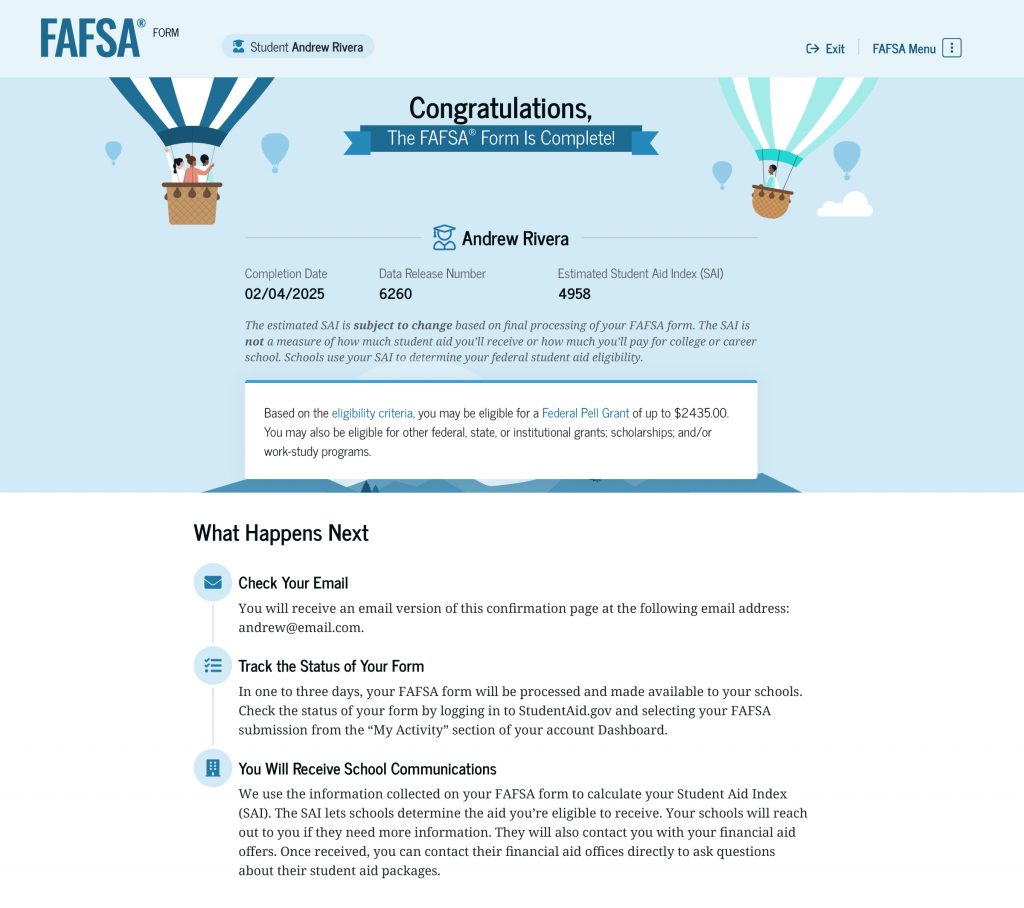
If you have other contributors who still need to complete their FAFSA sections, you’ll see an abbreviated confirmation page after you submit your sections of the form. A contributor is anyone (you, your spouse, your biological or adoptive parent, or your parent’s spouse) who is required to provide information on the FAFSA form, sign the FAFSA form, and provide consent and approval to have their federal tax information transferred directly from the IRS into the form.
Each contributor you invited to your FAFSA form must log in to their own StudentAid.gov account to complete their sections and sign the form. Note: Your FAFSA form can’t be fully processed until your contributors complete and sign their sections. The full confirmation page and information will be emailed to you once all required sections are complete and your form is submitted.
Your confirmation page will include any next steps you may need to take for your FAFSA form. This may include immediate actions, such as providing consent and approval or a signature from a contributor. Remember: You and your contributors must provide the required information, consent and approval, and signature for your FAFSA form to be complete and for you to be eligible for federal student aid.
What’s included on your confirmation page?
After your FAFSA form is submitted successfully, the confirmation page will list your estimated Federal Pell Grant eligibility and your estimated Student Aid Index (SAI). The SAI is an index number (ranging from –1500 to 999999) that’s calculated using the information provided on your FAFSA form. Note: Your official SAI will be listed on your FAFSA Submission Summary, which we discuss in the next section of this article.
Schools will use your SAI to calculate the amount of aid that you may be eligible for. The SAI is NOT a dollar amount of aid you’ll receive, the amount of money that you or your family is expected to pay for school, or your financial aid offer.
A lower or negative SAI indicates to your school that you have higher financial need. It also means you’ll have a higher likelihood of qualifying for a Federal Pell Grant.

Your SAI is calculated each year that you submit a FAFSA form. In most cases, your SAI will change every year depending on updates to the SAI formula (as determined by law) and information that you (and your contributors, if required) provide on the FAFSA form. Learn more about the SAI and how it’s calculated.
When reviewing your FAFSA confirmation page, keep in mind that this is not your financial aid offer. You’ll get that separately from the school(s) you apply to after you’re accepted for admission.
Checking the Status of Your FAFSA® Form
If you want to confirm your FAFSA form has been submitted or check the status of your form, follow these steps:
- Log in to StudentAid.gov using your account username and password.
- Navigate to your account Dashboard. Locate your FAFSA form under the “My Activity” section.
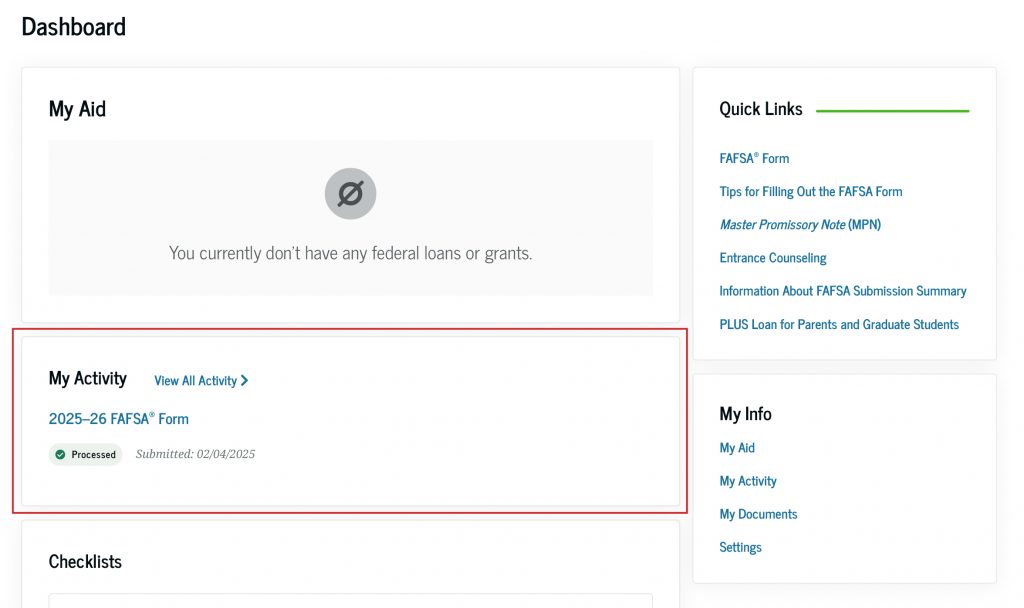
In this section, you may see the following:
- Draft—you’ve started your FAFSA form but haven’t completed your required sections.
- In Progress—you’ve completed your required sections of the FAFSA form but haven’t submitted the form.
- Action Required—you’ve completed your required sections but there was an error, and a correction is needed. This may include missing consent and approval and/or a signature.
- In Review—your form was submitted but hasn’t been processed yet.
- Processed—your FAFSA form was processed successfully with no errors.
- Closed—your FAFSA form was started but wasn’t submitted before the deadline.
To review details about your application, select your FAFSA form in the “My Activity” section.

2
Review your FAFSA Submission Summary.
After your online FAFSA form is submitted, it will be processed in one to three days. Once your FAFSA form is processed, you can log in to your StudentAid.gov account to view your FAFSA Submission Summary.
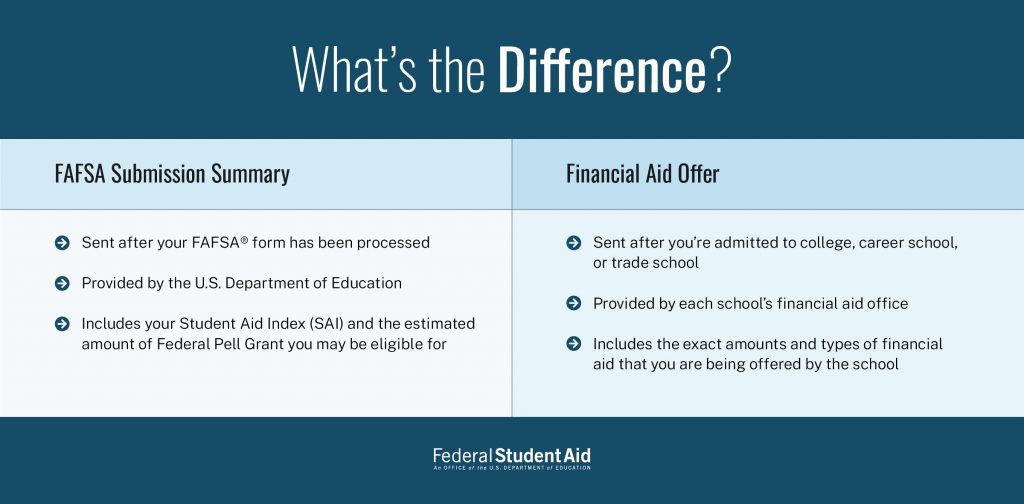
Your FAFSA Submission Summary is not your financial aid offer, but it will include important information across four tabs. Review each tab carefully to make sure the information is correct and take any actions listed on the final tab. Each tab covers a specific topic:
- Eligibility Overview includes estimates of your federal student aid and your confirmed official SAI.
- FAFSA Form Answers includes the responses you provided on your FAFSA form and the ability to start a correction if you notice any errors.
- School Information includes details about the schools you listed on your FAFSA form for you to compare.
- Next Steps includes information for your awareness and actions you may need to take for your FAFSA form.
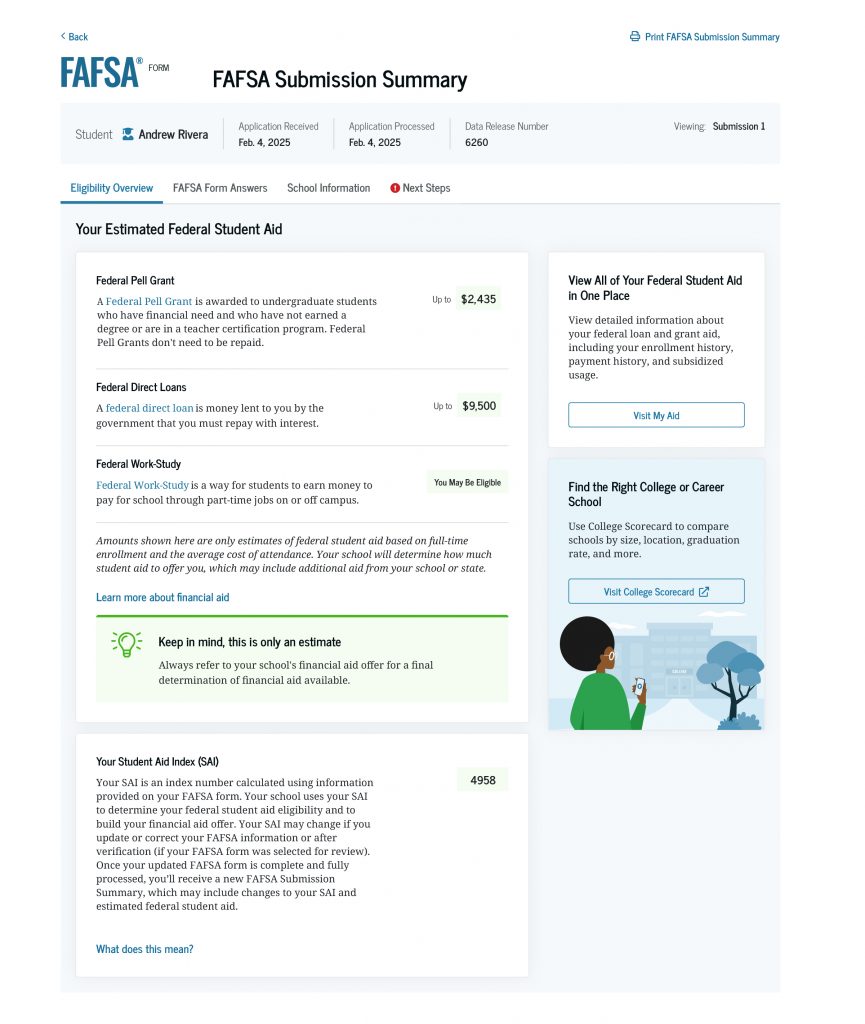
One of the next steps you may see listed on your FAFSA Submission Summary is making sure your schools have everything they need. Some schools may require additional information. For example, if you indicated on your FAFSA form that you have unusual circumstances or that you’re homeless or at risk of being homeless (but you haven’t received a homeless youth determination), you will need to contact your school(s) to find out what documentation you may need to submit.
You may see a note on your FAFSA Submission Summary that says you’ve been selected for verification. Verification is the process that schools use to confirm that the data reported on your FAFSA form is accurate. Being selected for verification doesn’t mean that you did anything wrong. You may be selected at random, and some schools verify all students’ FAFSA forms. If you’re selected for verification, make sure you submit any required documentation to your school by the appropriate deadlines to avoid issues with your financial aid.
To learn more about the FAFSA Submission Summary, read our “What You Need To Know About the FAFSA Submission Summary” article.
3
Make FAFSA® corrections, if needed.
After your FAFSA form has been processed, you can go back and submit a correction for certain fields. This includes updates as instructed by your school, correcting a typo, and/or adding another school to receive your FAFSA information. You can add up to 20 schools to your online FAFSA form at a time.
If you want to report significant changes in your family’s financial circumstances, contact the financial aid office at the college, career school, or trade school you plan to attend.

To begin a correction, go to your FAFSA Submission Summary and then select “Make a Correction” at the top of the FAFSA Form Answers tab. You can also make a correction by logging in to your StudentAid.gov account and selecting your FAFSA submission in the “My Activity” section of your account Dashboard.

Note: Contributors (including a parent, stepparent, or spouse) can begin a correction, but they can only submit corrections for their own sections of the FAFSA form. Students can begin and submit a correction for any section of their FAFSA form.
4
Complete your state’s aid application.
Student aid doesn’t come only from your school and the federal government. Student aid is also available from your state. Some states only require that you complete your FAFSA form to be eligible, but other states may require you to complete a separate application.
Many states have limited funds, so understand your state’s requirements and apply early to be eligible for as much aid as possible. You can find more information about state aid, including types of aid available, eligibility requirements, applications (if required), and deadlines, by visiting your state’s higher education agency website. Contact your state’s higher education agency if you have any questions.
5
Compare schools and out-of-pocket costs.
Even before you receive your financial aid offers, you can begin researching and comparing the schools you included on your FAFSA form. Each school will have a different cost of attendance and may include different items in their calculation.
To compare schools, try College Scorecard to review key information on up to 10 schools at once, including average costs and net prices (your out-of-pocket costs). You can also compare average graduation rates, post-school earnings, post-school student loan debt, and other information. College Scorecard can help you understand which school may be most affordable to you, so you can make a more informed decision on where you want to attend.
6
Apply for scholarships.
Since many schools won’t be able to meet your full financial need, you’ll need a way to pay the difference between the financial aid your school offers and what the school costs. Scholarships are a great way to fill the gap.
Don’t wait until you receive your financial aid offers to start applying for scholarships. There are thousands out there, but many have early deadlines. Set a goal for yourself; maybe you aim to apply to one scholarship per week. Make scholarship applications your focus while you wait for your financial aid offers. The applications may take some time, but the possible payout makes it all worth it. For more tips, read our article on applying for scholarships.
Avoiding Scholarship Scams
While you’re researching scholarships, watch out for possible scams. Check that the scholarships are legitimate and the information you’re finding comes from a trusted source.
Keep in mind that you don’t have to pay to find scholarships or other financial aid. Check out our “Avoiding Student Aid Scams” page for information on how you can protect yourself from scams.
7
Evaluate your aid offers.
After you submit your FAFSA form, the schools you’ve been accepted to will use the information you provided to create your aid offers (which determine your out-of-pocket costs to attend a school).
All financial aid offers—sometimes called award letters—are different. Wondering how you can tell which school (and aid offer) is the best fit? Follow the steps in our “How To Evaluate Your Aid Offers” article to create an action plan to compare your aid offers and accept the one that’s right for you.
